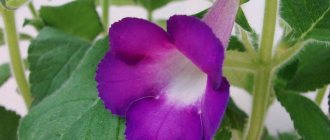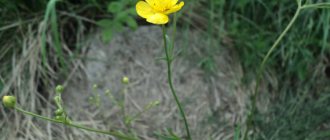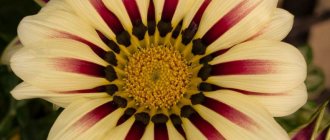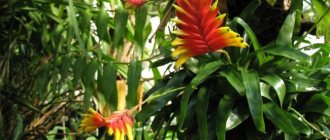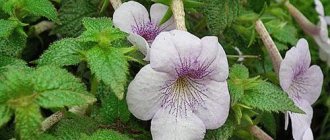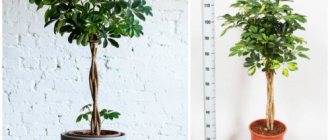Achimenes Sabrina has a large pear-shaped bulb covered with brown scales. First, flower stalks emerge from it; after flowering, linear green leaves about 40 centimeters in length appear. In our conditions it blooms from late summer to early autumn. But if the care is correct, then flowering is possible even 2 times a year.
It is recommended to leave no more than two peduncles, at the top of which there are large, bell-shaped, six-petalled flowers of attractive color. Flowers are collected together from 3 to 12 pieces in so-called “umbrellas”. After pollination, seeds of 50-80 pieces in each ripen in boxes. The plant is poisonous, so precautions should be taken when handling it.
Growing at home
Growing Achimines Sabrina (Sabrina) is possible in gardens and indoor conditions. Garden specimens are planted in June-July in containers or open ground. In September, the bulb is dug up and stored in a dry place, maintaining a temperature of 180 degrees Celsius. The problem with growing in open ground is that if there is a sudden cold snap, the plant may not have time to bloom, so it is preferable to plant it in a portable container.
Achimines Sabrina is planted at home in a container corresponding to the size of the bulb. The distance from it to the edges of the container is about 2 cm. The substrate for planting includes two parts of leaf soil with the addition of the same volume of turf, plus two parts of perlite and one part of humus.
During flowering, you need to water abundantly. After wilting, the volume and frequency of watering decreases. Peduncles are cut off at a distance of 3-4 cm from the base. When the leaves of the plant begin to fade, watering must be completed without waiting for the last leaf to fall off, because rot may appear.
During the dormant period, the dishes are transferred to a cool, dark place for 3 months; there is no need to water them. After the end of sleep, the bulbs are transferred to a bright, warm place; the abundance and regularity of watering is determined by environmental conditions. The flower is not picky about air humidity; in very dry air, the buds can be sprayed.
Conditions for growing indoor Achimenes
Among beautifully flowering plants, many species boast similar “average” requirements for growing conditions. Achimenes surpasses even the selected unpretentious ones, because there is no need for him to organize a cool winter. It is enough to choose bright, intense lighting - and in an ordinary room this plant will feel quite comfortable.
Achimenes are seasonal houseplants. During the dormant period, they completely shed their leaves, resuming growth only after several months of suspension of the growing season. For Achimenes, the dormant period traditionally occurs in autumn and winter: the leaves die and dry out in October, and active vegetation resumes in February.
Lighting and placement
The light-loving nature of Achimenes requires very careful selection of the growing location, and the sensitivity of leaves and flowers to direct sun, which instantly leaves burns, limits placement options. Achimenes love diffused, bright places.
It is better to place this plant on windowsills; artificial additional lighting does not compensate for the lack of natural light: if plants are grown with additional lighting, then it should be constant, lasting from 14 to 16 hours a day. Only species Achimenes love her.
During the dormant period, when the plant sheds all above-ground parts, the achimenes is moved where it is convenient, to any dark place - until the time when it begins to grow again. At the very beginning of shoot growth, Achimenes are kept in partial shade or in diffused light. They are moved to the usual lighting for the active growth phase only after the shoots have risen to 6-8 cm.
Achimenes - plants for decorating living rooms. But they should be placed in living rooms only when their appearance fits into the style of the interior. Achimenes may lose their attractiveness in the company of more formal or lacy plants, but they look good alone or with other nostalgic crops.
Suitable for nostalgic, romantic and classic interior styles or where color and texture are emphasized. These South Americans feel great in the kitchen, where their elegance and chintz look especially festive.
When placing achimenes, it is worth considering that they fully reveal their beauty only when placed slightly elevated or at the same level with the eyes.
It is better to place this plant on windowsills; artificial lighting does not compensate for the lack of natural light. © miculparadis
Temperature and ventilation
Achimenes are heat-loving plants. They seem to be created for residential premises. After all, the most comfortable temperature for them is considered to be from +18 to +25 degrees. Throughout the year, regardless of the stage of development, plants must be protected from sudden cold spells. Cold is destructive for Achimenes, but heat also negatively affects not only flowering, but also leaves, leading to a rapid loss of decorativeness.
For Achimenes, it is unacceptable for the air temperature to drop to +16 degrees, but in summer it is better to increase the minimum permissible value to 20 degrees Celsius. During wintering of Achimenes without soil, the optimal temperature is about 16 degrees, but even when stored in a substrate, rhizomes overwinter better in slightly lower rather than hot temperatures.
Achimenes need to be protected from temperature changes and sudden changes in conditions. This is a delicate plant that can suffer from drafts (they are especially dangerous at the flowering stage). At the same time, plants feel great on balconies and in the garden, provided that protected places are chosen and night temperatures are controlled.
Reproduction of Achimenes Sabrina
Flowers can be propagated by seed and vegetative methods. To obtain seeds, the buds are cross-pollinated with a brush. The seeds are removed from the ripened capsules and immediately sown in the prepared substrate. Its composition: leaf soil is mixed with sand (2 parts each), plus turf soil and humus (1 part each). The seeds are sprinkled on top with a layer of earth (5 mm thick). Necessary conditions: constant soil moisture and temperature 22-25 degrees Celsius. Seedlings dive into 100 ml pots after the appearance of 2 leaves. The development of young plants with this method of propagation is quite long.
A simpler method is to divide the bulb, from which the baby bulb with roots is separated during transplantation. When planting, 1/3 of its height should remain above the ground. The composition of the substrate is the same as when planting an adult plant. A young specimen will be able to bloom after 2 years. A photo of this plant is shown in the article.
Diseases, pests and problems in growing
Most often, Achimenes suffer from rot, which threatens plants when the soil is waterlogged and improperly watered. But pests also adore their special leaves. Achimenes are easily infested with mealybugs, aphids and spider mites. Thrips are also not uncommon on these plants.
If there are problems with care, plants instantly show signals about violations of comfortable conditions. So, watering with cold water manifests itself in spots on the leaves, dry air - in the drying out of their tips, and in the heat and dry air, Achimenes lose buds.
Photo of flowering
The variety is notable for its numerous small flowers of pale ruby color and a bright yellow center. The diameter of the flowers is on average about 2 centimeters.
In the photo Achimenes Sabrina:
Achimenes flowers
Do you know what growing and caring for Achimenes involves? We discover the secrets of maintaining and growing Achimenes. Achimenes come from America (South and Central). The plant is loved by gardeners for its long, colorful, abundant flowering. Under natural conditions, it blooms all year round; this is favored by the tropical forest microclimate. Flower color: white, orange, red, yellow, purple. The name "Achimenes" is translated in Greek as "afraid of the cold." You can look at the variety of flowers in the article Achimenes flowers photo varieties.
Description of Achimenes
Achimenes is a herbaceous perennial plant. No more than 30 cm in height. The stems are fleshy, branched, dark green or red. At first they grow upward, but droop with age. The rhizome is aboveground with rhizomes (tubers) covered with small scales. They accumulate useful substances that the plant will use after leaving winter dormancy.
The oblong leaves on petioles with a sharp end on the outside are smooth and shiny. They come in dark green, pink, and purple with raised veins. There are small hairs from the inner area of the plate.
At the end of spring, many flowers begin to form in the axils of the leaves along the entire length of the stem. Each corolla has a tube and 5 strongly bent, double or simple petals, separated along the edges.
Reddish, pink, yellow, snow-white, purple flowers are arranged singly or in groups of 3-6 pieces. They reach 3-6 cm in diameter. Flowering occurs until the end of September. When grown at home, it can be observed twice.
Reproduction methods
Achimenes is propagated at home in the following ways:
- Rhizomes.
- By cuttings.
The first method is preferable because the sprouted plant will already have a root system, which will allow further healthy lush growth and give rise to up to a dozen new rhizomes.
While propagation by cuttings allows the plant to take root only after 2-3 months and only then will they be able to form new rhizomes, which will give rise to plants only in the next season.
In summer, cuttings are carried out. Select strong young shoots and cut off 10–12 cm pieces from them. Each part should contain 1–2 internodes. The cuttings are then placed in water for rooting. The fluid is completely replaced after 1–2 days. After the roots appear, the cuttings are planted in fertile soil.
Cuttings can also be rooted in soil. After planting, they are placed in a warm place and covered with a glass container or plastic bottle. The cover is removed after 7–10 days.
Cuttings
This method is rarely used, since cuttings are difficult to protect from rotting. Cuttings are carried out in the summer. Only the lower and middle part of the shoot, 5 centimeters high, is suitable. Rooting of Achimenes occurs in wet sand. It is necessary to cover the rooted cutting with a glass jar or plastic bag. To achieve rapid rooting, the lower part of the cutting is treated with a root formation stimulator. “Heteroauxin” or “Kornevin” will do. Bottom heating also speeds up this process. Rooting takes from 12 to 15 days. When small nodules appear at the base of the stem, Achimenes is transplanted into a substrate for adult plants.
Winter storage of young plants obtained by the last two methods has some peculiarities. Since their rhizomes are small, it is not recommended to reduce the temperature too much. It is better to leave them in a bright window, where it will be about 20 degrees Celsius. Infrequent moderate watering will be required.
Seeds
Another way is to propagate Achimenes using seeds. But what is worth knowing here is that when planting, the varietal characteristics of the parent are not transferred to the plant. The bush is mainly pollinated artificially - they ripen 2-2.5 months after the flower withers. The fruits become soft and seeds can be easily removed from them for future planting.
Seeds are sown in February-March on top of a light substrate (sand plus turf and leaf soil) or moist, coarse sand with good drainage. Achimenes is planted at home as seedlings.
Common varieties
All the many varietal varieties of the plant come from long-flowered (longiflora) and large-flowered (grandiflora) achimenes.
| Name | Leaf color | Flower shape and color |
| Cote d'Ivoire | Rich green | They can be double or semi-double with a light yellow base color with a bright yellow center from which brownish rays emerge. As you can see in the photo, there are spots of light lilac color along its jagged petals |
| Peach blossom | Bright green | The form is simple. The color is purplish-red with gold flecks throughout the flower. |
| Ice tea | Bright green | The petals are simple with a wavy edge of pinkish-peach color. Along the bright yellow throat there are dots and streaks of burgundy color (see photo) |
| Yellow english rose | Dark green | The edges of the petals are decorated with fringe, which gives the flowers a resemblance to roses. Color varies from light yellow to peach |
| Sauline | Bright green | They can be double or semi-double with a light yellow base color with a bright yellow center from which brownish rays emerge. As you can see in the photo, there are spots of light lilac color along its jagged petals |
| Serge saliba | Rich green | The shape can be terry or semi-double. The color is bright red with pink-orange tints. The bright yellow center is covered with red spots and streaks |
| Dot | Dark green | The light pink or lilac petals of the simple flowers are covered with a blue-violet net. Throat bright yellow |
| Strawberry lemon | Light green | The form is simple. The color of the petals is yellow, with raspberry-colored spots distributed unevenly along them, which over time acquire a peach tint. Brownish rays come out of the throat |
| Rainbow warrior | Dark green | The petals of simple flowers have a wavy edge and a blue-violet color. The yellow throat is decorated with rays of dark purple color |
| Nero | Bright green | The form can be either semi-double or simple. The color of the petals is bright red. The throat is yellow and covered with brownish rays |
| Sabrina | Light green | Flowers of simple shape have bright pink petals and a yellow throat. |
| Abendrot | Light green | Terry shape, yellowish-peach color |
| Ambroise verschaffelt | Rich green | Flowers of simple shape have bluish petals. The throat is yellow, violet rays come out of it |
| Honey queen | Dark green | The light yellow petals of simple flowers are decorated with a bright purple border, along which yellow spots are scattered. Throat bright yellow |
| Double pink rose | Light green | Double-shaped flowers have a soft pink color |
| Last dawn | Light green | Small specks are scattered on the petals of double flowers of lilac-raspberry color |
| Blueberry lemon | Light green | Double and single yellow flowers with a lilac pattern can bloom on one bush |
| Peach orchard | Bright green | Double-shaped flowers have a bright peach color |
| Nightfall | Light green | Terry flowers of bright cherry color |
| Glory | Dark green | The shape of the flowers is simple, the color of the petals is bright red, the throat is yellow |
| Alter ego | Bright green | The color of double flowers can be light blue or blue-violet |
| Purple king | Light green | Simple flowers have a bright lilac color, petals with fringe and a mesh pattern |
| Petite fadette | Dark green | Double bright red flowers with a dark red center |
| Yellow fever | Bright green | Flowers of double or semi-double form have a bright yellow center and pinkish petals at the edges |
| Lemon orchard | Light green | Light green Terry flowers of soft yellow color are decorated with a pink border and red strokes |
| Hard to get | Bright green | Flowers can be double or semi-double. The color of the petals is fuchsia-raspberry, the throat is yellow, with cherry spots around it. |
| Sun wind | Dark green | Flowers of simple shape can be white or light pink, which becomes more intense at the edges. Throat yellow with speckles of orange or reddish-brown color |
| Caprice | Dark green | Wavy petals of simple flowers of lilac color, the center is formed by rays and spots of yellow and brown color |
| Peach glow | Dark green | Flowers of a simple shape have jagged edges and a delicate peach color, the throat is yellow |
| Hugues aufray | Dark green | Simple flowers with bright yellow petals, decorated with a lilac-lilac border. |
| Red elfe | Dark green | Bright red simple flowers, the center consists of brown dots and streaks |
| Golden lady | Dark green | The simple-shaped flowers have light yellow petals with lilac-pink edges and the same pattern. There may be another yellow petal in the throat |
| Lady in black | Dark green | Simple flowers of a very dark wine color with rays in the center of dark brown and yellow color |
| Orange delight | Light green | The flowers have a simple shape and a bright reddish-orange color. The petals are wavy, the throat is golden with rays of brown and lilac. |
| Snow princess | Bright green | Simple flowers of white color with spots of yellow and purple color in the center |
Popular varieties
Today, several varieties of Achimenes are distinguished in cultivation, on the basis of which dozens of varieties have been bred. The most popular among them are described below:
- Long-flowered - plants up to 30 cm high. The ampelous stems are decorated with slightly elongated pubescent leaves of light green color. Large flowers are located singly in the axils of the leaves.
- Large-flowered - bushes up to 60 cm high. Erect stems are decorated with large elongated leaves. Purple-red flowers are arranged in pairs in the axils of the leaves.
- Hybrid - forms created by crossing several species. The ampelous or erect stems are decorated with pointed, pubescent leaves with jagged edges. They are famous for the original colors of their flowers, which delight with their abundant blooms.
Plants can have both regular and double flower shapes. The color palette of shades is wide. It covers all shades, starting with light shades such as white, yellow, pink, coral, lilac, blue and ending with dark ones - violet and sea green.
A brief description of the most popular varieties of Achimenes:
- Blue Star - bushes with erect stems, decorated with large flowers with corollas of a violet-blue hue. The petals have interesting colors in the form of applied strokes.
- Peach Cascade - bushes with erect, slightly drooping shoots are decorated with spectacular peach-orange flowers with a yellow spot at the central point.
- Serge Saliba - bushes with erect stems, decorated with two-tone “stars” with a yellow core and pinkish edges.
- Glory are compact ampelous plants that delight with abundant blooming of spectacular flowers with a yellow core and scarlet petals.
- Double Pink Rose - lush flowering bushes with semi-double flowers of a pale pink hue, vaguely reminiscent of half-opened rose buds in shape.
- Purple King - bushes with erect stems, decorated with large lilac flowers with yellow speckled throats. The long-flowering variety pleases the eye from early spring to late autumn.
- Sauline - plants with erect stems, crowned with small flowers with jagged edges of an original lemon-purple color. Depending on the growing conditions, the color tone can change from yellow to pink.
- Lavender Fancy - ampelous plants with burgundy stems and light green foliage, decorated with simple flowers of striped creamy-brown color.
- Peach Blossom - ampel-shaped bushes. They are distinguished by spectacular foliage, the upper part of which has a dark green tint, and the lower part is burgundy. The flowers of the plant also include two shades: the center is decorated with a purple “eye”, the edges are pale pink.
Features of Achimenes
Translated from Greek, the name of the flower means “those who are afraid of the cold.” In the coldest months of the year, the plant actually feels uncomfortable even in a warm apartment, and therefore goes into a short “hibernation”, but it pleases its owner with flowers for quite a long time - from May to October.
The variety of colors is as rich as in the natural habitat.
In addition, breeders have made their contribution - many varieties of Achimenes have been created with unusual colors, which are never found in nature.
Achimenes come in upright and ampelous (the latter are most actively used in indoor floriculture), terry and simple.
As for shades, there are a lot of options - plain and with various inclusions. The flower calyx is 2-5 cm in diameter, and the length of the stems ranges from 20 to 60 cm depending on the variety.
The flowers are very delicate and their lifespan is short. However, the plant does not lose its decorative value, because the wilted ones are immediately replaced by new buds. They are located along the entire length of the stem in the leaf axils, forming a bright garland.
A distinctive feature of Achimenes is the nodules located on the roots, very similar to birch catkins or miniature spruce cones. These are rhizomes, excellent planting material, so originally invented by nature itself.
Flowering period
The flowering period begins in May. It is in this month that buds are laid and buds are formed. During the flowering period, the plant requires a lot of light, more moisture and systematic feeding.
The flowering phase ends in September. Fewer and fewer flowers appear and they fall off. In some species this phase can last until October. From this month, the plant begins to prepare for winter sleep. Its leaves turn yellow, turn brown and fall off. As a result, only rhizomes remain for the winter.
Care
Tropical achimenes is able to bloom in almost any conditions. It needs light and comfortable humidity, and everything else is minor details!
Temperature
The best temperature for heat-loving achimenes is 20-25 degrees, and in winter for tubers - 13-15 degrees. In summer, the flowerpot can be taken outside, onto the veranda or onto an open balcony.
Soil and pot
The soil for planting Achimenes should be loose and light. To make your own soil, you can take leaf soil (3 parts), peat (1 part), sphagnum moss (1 part), coarse sand (1 part). The following substrate is also suitable for achimenes: leaf soil (2 parts), turf soil (3 parts), humus (1 part), coarse sand (1 part). Sand can be replaced with perlite (vermiculite), then the substrate will retain moisture longer.
You can add a little charcoal, mullein and shell rock to the prepared soil mixtures. Ready-made soil is used for planting ornamental flowering plants. The drainage layer should fill one third of the pot.
Achimenes has short roots, so it requires a wide, low container, since in a high pot the soil may begin to sour, which leads to rotting of the root system. For those plants that are grown as hanging plants, use hanging flowerpots.
Lighting
Choose a sunny place, but in the heat of the day it is better to avoid direct rays. Too harsh midday sun can burn delicate leaves and petals.
Watering
Achimenes prefers moist soil, so it is watered as the top layer dries. But in winter, during the dormant period, we advise you to avoid watering as much as possible. Leaves cannot be sprayed, but you can place trays with wet sand or moss.
Feeding
For young, actively developing and flowering achimenes, timely feeding is extremely necessary. Most often, they are carried out once every 7-10 days, using special complex fertilizers for indoor flowers. Fertilizing with Fertika Lux gives very good results.
During the formation of buds, it is recommended to feed plants with fertilizers containing phosphorus and potassium. Fertilizing with a high nitrogen content should be applied with caution, since an excess of this element in the soil mixture can provoke vigorous development of green mass and weak budding.
For very young Achimenes growing root mass, phosphorus-based fertilizers are recommended. This element plays an important role in the proper formation of roots. Typically, at this stage, flower growers use the “Rikat Start” product.
Replanting and pruning
Achimenes is transplanted every year in early spring after it emerges from the dormant period. The tubers are planted in small boxes and transferred to a room with a temperature of about twenty degrees. After the emerging shoots have grown sufficiently, the young plants are transplanted into separate pots.
Achimenes: care and cultivation
In order for the bush to develop well and bloom flowers, it is necessary to provide it with certain conditions:
| Factor | Spring Summer | Autumn winter |
| Location | Any window sills, except northern ones, with shading from the midday sun. Take it out onto the terrace or loggia. | Move to a dark, cool closet for winter rest. |
| Lighting | Bright light is needed. Variegated varieties do not tolerate direct sunlight; they need to be shaded. Varieties with dark greens can withstand short exposure to ultraviolet light. | Do not use additional lighting, rest period. |
| Temperature | +22…+23 °С | +15 °С |
| Humidity | 60-65%. You cannot spray the plant itself, only the air around it. You can also pour wet expanded clay into a tray, place a pot on top, or purchase an air humidifier. If water gets on the greens, large dark spots will appear on them. The bush will lose its decorative appearance. | |
| Watering | Abundant, every 3 days. | When the earth dries out. Produce in small portions along the edge of the pot (once a week, 2-3 tablespoons). |
| The water temperature is approximately 2° above room temperature. Make sure that there is no stagnation of moisture. Apply at the root or in a tray, avoiding contact with foliage and shoots. | ||
| Top dressing | 3-4 weeks after the sprouts appear. Subsequent ones - every 2 weeks with mineral fertilizers. | Not necessary. The bush is resting. |
Transfer
Young and mature plants need to be moved to a different pot every year. Before winter dormancy, rhizomes are not dug up, but stored in an old substrate in a dark room. Transplantation is done before the growing season:
- Lay out drainage from pebbles, expanded clay or crushed bricks.
- Fill 2/3 of the container with a soil mixture of leaf soil, turf, sand (3:2:1).
- Remove the tubers from the old soil and place them in a new pot in a horizontal position.
- Pour 5-10 mm of substrate on top and water carefully.
- Cover with glass or polyethylene to create greenhouse conditions until shoots appear.
Reproduction of Achimenes
The flower is bred:
- rhizomes;
- cuttings;
- seeds.
The first method is the simplest and most effective. One rhizome can produce several shoots at once; young specimens retain the varietal characteristics of the mother bush.
Reproduction occurs like this:
- Carefully separate the tubers from the roots.
- Distribute over the surface of pre-moistened soil.
- Sprinkle 2 cm with dry soil.
- Make sure that the soil does not have time to dry out, keep it at a temperature of +22 °C.
- The sprouts will sprout in 1-2 weeks. After the first leaves appear, replant the shoots.
Propagation by cuttings is carried out in May-June. Step by step planting process:
- Divide a healthy and fully formed branch into 3 parts. They must have at least 3 internodes.
- Remove the lower leaves for better rooting.
- Treat the cut areas with crushed activated carbon.
- Place the lower cutting in a root growth accelerator (for example, Kornevin).
- Plant in a moist, warm substrate.
- Cover with plastic wrap or a glass jar for a greenhouse effect.
- Remove the cover daily for ventilation. Remove condensation from the walls.
- The first roots will appear after 10-14 days.
The last method of breeding is considered the most difficult and time-consuming, since the seeds of the plant are very small. Usually breeders and experienced flower growers resort to it. Step-by-step instruction:
- In March, mix the seeds with a small amount of sand.
- Sprinkle the mixture onto pre-moistened soil.
- There is no need to sprinkle them on top, otherwise there will be no sprouts for a long time.
- Cover with polyethylene to create a greenhouse.
- Remove the film daily to ventilate and moisten the substrate using a fine spray bottle.
- The first shoots will appear no earlier than in half a month, if bright lighting is provided.
- Pick at least 3 times per spring.
Bloom
The buds begin to form in late spring and bloom in June. Flowering is characterized by an undulating flow: some flowers gradually fade, while others bloom. This continues until September-October, when due to lack of light and heat the plant enters the dormant phase.
Important! Such time intervals are typical for Achimenes, whose rhizomes are planted in late February - early March. If the planting dates are shifted, then flowering will begin later.
Rest period
With the onset of autumn, with the end of flowering, the plant begins to prepare for the dormant period. By this time, fertilizing the plant is stopped and watering is sharply reduced. Leaves stop growing, turn yellow and die, nutrients and moisture accumulate in the roots. When the above-ground part of the plant dries out (the roots will draw out all the useful substances from it), it must be cut off and the tubers left in a pot or placed in sand. The pot with tubers is placed in a cool, dark (14-16 degrees) place. Watering is carried out with settled warm water once a month, very carefully, along the edge of the pot, only slightly moistening the earthen ball - excess moisture can provoke premature awakening of Achimenes from sleep.
Advice! If the plant still awakens ahead of time, it should be provided with a lot of light using daylight lamps for plants - this will help the normal development of the stems.
Peculiarities
Achimenes is a relative of the Uzambara violet (Saintpaulia), belonging, like it, to the Gesnerieceae family. This close relationship largely determines the similarity of the requirements of these plants for conditions of maintenance and care.
Being a representative of the tropical flora of South and Central America, this flower needs comfortable living conditions. However, during the winter dormancy period, Achimenes becomes less demanding, which greatly simplifies its care.
A characteristic feature of this plant is its specific transition to the winter dormancy phase. During this period, the above-ground part of Achimenes dies off, which causes anxiety and even panic among inexperienced gardeners.
Indeed, at first glance, drying and wilting of leaves at this stage can be mistakenly perceived as signs of plant death. However, these processes are completely natural for Achimenes.
After the death of the above-ground part, which the plant gets rid of for economical use of resources, the rhizomes (rhisomes) plunge into a dormant state. With the arrival of spring, the root system wakes up and begins to form new shoots. If you provide the plant with proper care at this time, it can please its owner with abundant flowering twice in just one season.
To date, breeders have developed many hybrid varieties of Achimenes of the most unusual colors and shades. There are varieties with simple and double, large and small flowers.
If the cultivation of indoor achimenes is carried out in accordance with all care requirements, then it enters the first flowering phase in May and can delight with its elegant appearance almost all summer. The second flowering phase usually occurs in late summer and early autumn. At this stage, the plant forms flowers of a smaller size and in small quantities, but this does not at all affect its beauty and decorativeness.
The flowers of this amazing exotic are notable for their funnel- or bell-shaped shape, variegation of colors, richness and variety of shades. The color palette of Achimenes is very extensive. It contains milky white, caramel yellow, pale and dark pink, purple, lilac, carmine red, lilac, light and dark blue tones. Achimenes with two-color striped and speckled flowers are very common in indoor plant growing.
Another important feature of these plants is their relatively long flowering time. Despite the fact that the lifespan of flowers is not very long, they are replaced in a timely manner by new buds. Thanks to this, flowering seems not only long-lasting, but almost continuous.
The most popular among gardeners are the ampelous forms of Achimenes, notable for their creeping and flowing shoots. However, this flower can be grown either erect or cascading.
Classification of Achimenes
All Achimenes are beautiful, but they are extremely heat-loving and die already at a temperature of 14 °C. It is this, as well as the need to maintain rhizomes during the dormant period in special conditions, that restrains their spread in culture.
There is no single classification of Achimenes based on external characteristics. Just like other popular representatives of the Gesneriaceae family.
Varietal and hybrid achimenosyphen are conventionally divided into groups. New cultivars are constantly appearing, which are difficult to limit within the framework of classification.
Separation according to the nature of shoot growth
Achimenes prefer to grow in bright sunlight. Some of them are grown in ordinary pots, others in hanging flowerpots:
- erect - with branches growing upward, rigid enough so that they can be formed into a compact bush;
- ampelous achimenes are distinguished by soft creeping or hanging shoots; their growth is usually not limited; pruning serves sanitary rather than decorative purposes.
